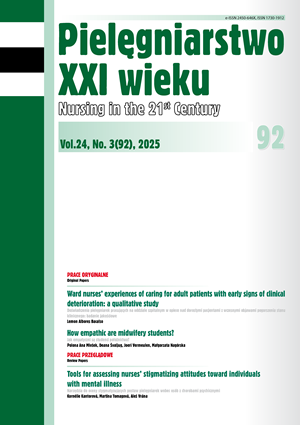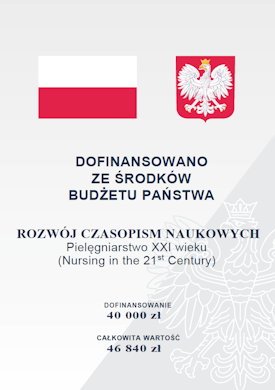The value of high-fi delity simulationin the professional development of emergencyservices – preliminary reports
DOI:
https://doi.org/10.12923/pielxxiw-2025-0028Keywords:
high-fidelity medical simulation, emergency response competencies, police, fire department, emergency medical servicesAbstract
THE VALUE OF HIGH-FIDELITY SIMULATION IN THE PROFESSIONAL DEVELOPMENT OF EMERGENCY SERVICES – PRELIMINARY REPORTS
Aim. The aim of the study was to gather the opinions of emergency service personnel, which are Emergency Medical Services, and the Fire and the Police Services- regarding workshops aimed at improving emergency response competencies using medical simulation methods.
Material and methods. The present study employed a descriptive, qualitative research approach. Researchers asked open-ended questions in the form of a survey directed at the workshop participants, with a focus on their opinions regarding the implementation of the workshop project using high-fidelity simulation methods.
Results. The content analysis of the interviews was coded to identify recurring patterns, themes, and categories, which formed the basis for organizing the results and drawing conclusions. The findings were presented in three key areas: the practical usefulness of the subject matter, the educational value of the medical simulation method, and prospects for the development of professional competencies.
Conclusions. Workshop participants who were emergency service representatives (firefighters, police officers, and paramedics) viewed the workshop topics positively. They expressed a preference for using medical simulation as a method that enables the acquisition and improvement of skills in conditions that are safe for both the learner and the patient/victim. The participants identified further training in pediatric procedures and tactical medicine as particularly desirable.
References
1. Gaba DM. The future vision of simulation in health care. Qual. Saf. Heal. Care. 2004; 13(1):1-10. https://doi.org/10.1136/qshc.2004.009878
2. Lioce L, et al. Healthcare Simulation Dictionary – Second Edition, Rockville, MD Agency Healthc. Res. Qual. 2020.
3. Kohn LT, Corrigan JM, Donaldson MS. To err is human: building a safer health system. Washington, DC: National Academy Press. 1999.
4. Tomaszewska K, Majchrowicz B, Trojnar P, et al. Medical simulation as a method of practical training in the opinion of nursing students. Nursing in the 21st Century. 2023; 22:85-92. http://doi.org/10.2478/pielxxiw-2023-0016
5. Fisher M, Vishwas A, Cross S,et al. Simulation training for Police and Ambulance Services: improving care for people with mental health needs. BMJ Simul Technol Enhanc Learn. 2020; 6(2):121-122. https://doi.org/10.1136/bmjstel-2018-000423
6. Saber DA, Strout K, Caruso LS, et al. An interprofessional approach to continuing education with mass casualty simulation: planning and execution. J. Contin. Educ. Nurs. 2017;48(10):447-453. https://doi.org/10.3928/00220124-20170918-05
7. World Medical Association. Declaration of Helsinki, Ethical Principles for Scientific Requirements and Research Protocols. World Med. Assoc. 1964. 2024; 29–32. https://www.wma.net/policies-post/wma-declaration-of-helsinki-ethical¬principles-for-medical-research-involving-human-subjects/
8. Tong A, Sainsbury P, Braig J. Consolidated criteria for reporting qualitative research (COREQ): A 32-item checklist for interviews and focus groups. Int. J. Qual. Health Care. 2007; 19(6): 349-357. https://doi.org/10.1093/intqhc/mzm042
9. Faria-Schützer DB, Surita FG, Alves VLP, et al. Seven steps for qualitative treatment in health research: the Clinical-Qualitative Content Analysis. Cien. Saude. Colet. 2021; 26(1):265-274. https://doi.org/10.1590/1413-81232020261.07622019
10. Krueger RA, Casey MA. Designing and conducting focus group interviews. Social Analysis Selected Tools and Techniques. 2001;36:4-23.
11. Nestel D, Hui J, Kunkler K, et al. A practical guide healthcare simulation research. Cham: Springer Nature Switzerland AG; 2019.
12. Roche A, Watkins E, Pettit A, et al. Impact of prehospital ultrasound training on simulated paramedic clinical decision-making. West J. Emerg. Med. 2024;25(5):784-792. https://doi.org/10.5811/westjem.18439
13. Husain S, Eisenberg M. Police AED programs: A systematic review and meta-analysis. Resuscitation. 2013;84(9):1184-1191. https://doi.org/10.1016/j.resuscitation.2013.03.040
14. Williams-Bell F, Kapralos B, Hogue A, et al. Using serious games and virtual simulation for training in the fire service: a review. Fire Technol. 2015; 51(3): 553-584. https://doi.org/10.1007/s10694-014-0398-1
15. Guise JM, Hansen M, Lambert W, et al. The role of simulation in mixed-methods research: A framework & application to patient safety. BMC Health Serv. Res. 2017; 17(1):1-7. https://doi.org/10.1186/s12913-017-2255-7
16. State of Victoria. Simulation and Patient Safety: The Benefits for Your Organisation. Melbourne: Department of Health & Human Services; 2015, p. 22.
17. Kardong-Edgren S, Jeffries P. The NCSBN national simulation study: a longitudinal, randomized, controlled study replacing clinical hours with simulation in prelicensure nursing education. J. Nurs. Regul. 2014;5(2):3-40. https://doi.org/10.1016/S2155-8256(15)30062-4
18. Marshall C, Van Der Volgen J, Lombardo N, et al. A mixed methods approach to assess the impact of an interprofessional education medical error simulation. Am. J. Pharm. Educ. 2020;84 (2):217-230. https://doi.org/10.5688/ajpe7133
19. Kumar A, Ameh C. Start here- principles of effective undergraduate training. Best Pract. Res. Clin. Obstet. Gynaecol. 2022;80:114-125. https://doi.org/10.1016/j.bpobgyn.2021.11.010
20. Karunathilake I. The role of simulation in Postgraduate Medical Education. J. Postgrad. Inst. Med. 2018;5(1):67. https://doi.org/10.4038/jpgim.8185
21. Padrez KA, Brown J, Zanoff A, et al. Development of a simulation-based curriculum for Pediatric prehospital skills: a mixed-methods needs assessment. BMC Emerg. Med. 2021;21(1):1-10. https://doi.org/10.1186/s12873-021-00494-4
22. Abelsson A, Lundberg L.Simulation as a means to develop firefighters as emergency care professionals. Int. J. Occup. Saf. Ergon. 2019; 25(4):650-657. https://doi.org/10.1080/10803548.2018.1541122
23. Avery P, Thompson C, Cowburn P. Training the trainers: improving the quality of education delivered to paramedics through a simulation-debrief model. Br. Paramed. J. 2023;7(4):51-56. https://doi.org/10.29045/14784726.2023.3.7.4.51
Downloads
Published
Issue
Section
License
Copyright (c) 2025 Katarzyna Zalewska, Jakub Zalewski, Tomasz Ilczak, Danuta Zarzycka (Autor)

This work is licensed under a Creative Commons Attribution 4.0 International License.




